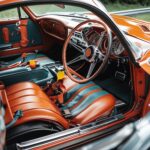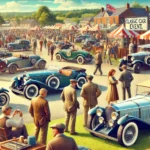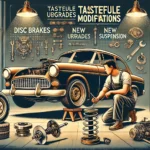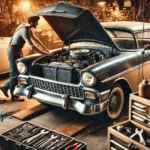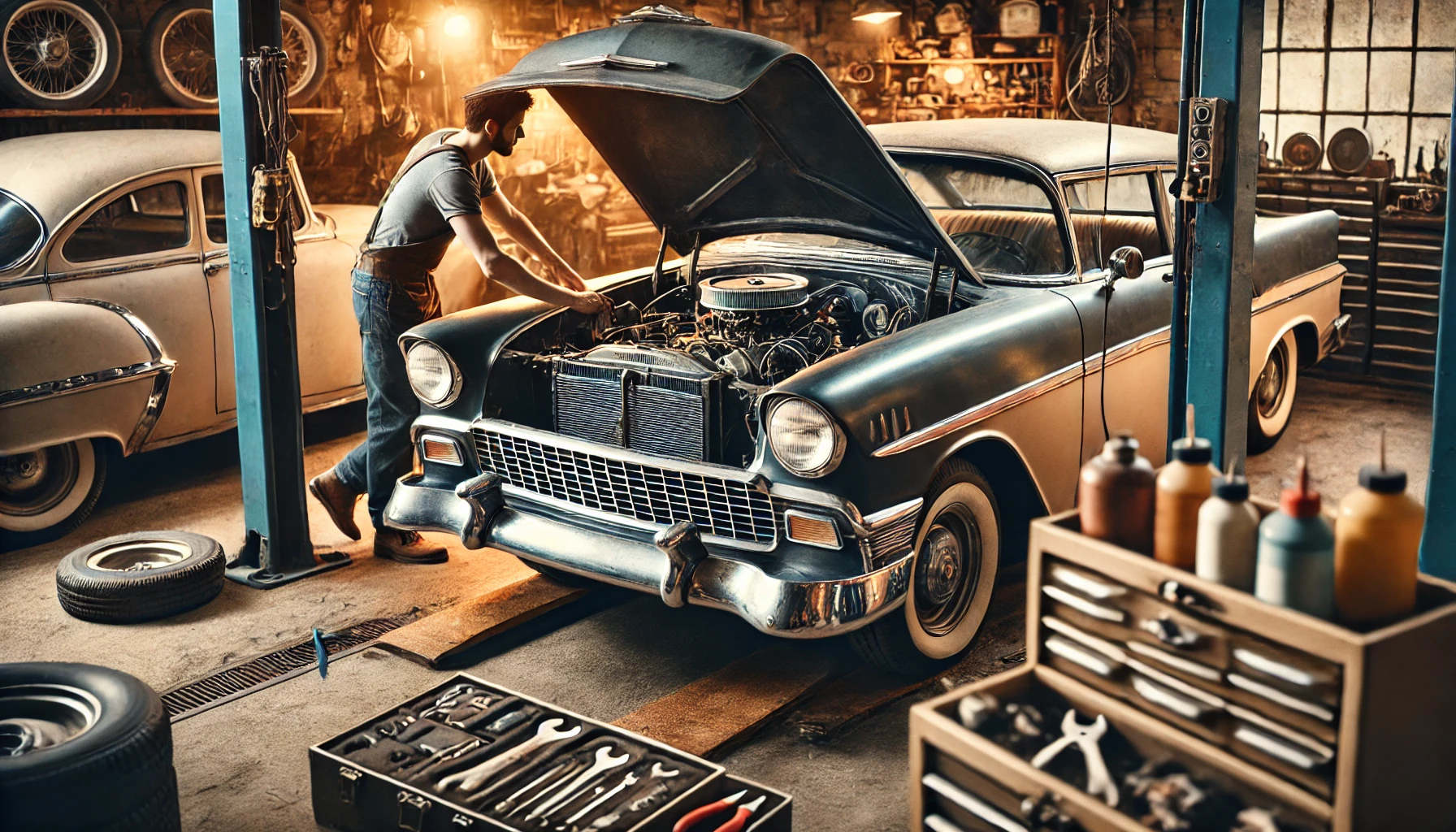Owning a classic car is a rewarding experience, but vintage vehicles often come with maintenance challenges. Unlike modern cars, classic models require special care to prevent mechanical failures and deterioration. Knowing the most common problems and how to fix them will help you keep your classic car in top shape.
1. Engine Overheating
🚗 The Problem:
Classic car engines are more prone to overheating due to older cooling systems and inefficiencies in design.
🔧 How to Fix It:
✔ Check the Radiator: Ensure it’s not clogged with debris or rust. A professional flush may be needed.
✔ Inspect the Thermostat: A faulty thermostat can prevent proper coolant flow. Replace if necessary.
✔ Upgrade the Cooling System: Installing a high-performance radiator, an electric fan, or an auxiliary coolant reservoir can help.
Pro Tip: Use modern coolant with rust inhibitors to protect older engines.
2. Electrical Issues
🚗 The Problem:
Wiring in classic cars degrades over time, leading to flickering lights, non-functioning gauges, or difficulty starting the engine.
🔧 How to Fix It:
✔ Inspect Wiring Harnesses: Look for brittle, frayed, or corroded wires and replace as needed.
✔ Upgrade the Fuse Box: Older fuses can corrode or blow frequently—replace with modern equivalents.
✔ Check the Grounding Wires: Poor grounding can cause intermittent electrical failures.
Pro Tip: If your car still uses a generator, consider upgrading to an alternator for a more stable electrical system.
3. Rust and Corrosion
🚗 The Problem:
Rust is one of the biggest threats to classic cars, especially in humid climates or areas where roads are salted in winter.
🔧 How to Fix It:
✔ Inspect Common Rust Areas: Check wheel wells, undercarriage, door sills, and the trunk floor.
✔ Remove Surface Rust Immediately: Use a wire brush, rust converter, or sandpaper to prevent further spread.
✔ Apply Protective Coatings: Rustproofing sprays and underbody sealants help prevent future rust.
Pro Tip: Store your classic car in a dry garage and use a dehumidifier if necessary.
4. Fuel System Issues
🚗 The Problem:
Classic cars often suffer from fuel delivery issues due to old gas tanks, clogged fuel lines, or worn-out carburetors.
🔧 How to Fix It:
✔ Use Fresh Fuel: Old gas can degrade and clog the fuel system—always use fresh fuel with an additive if storing the car.
✔ Check for Leaks: Inspect fuel lines and connections for cracks or leaks.
✔ Rebuild or Clean the Carburetor: A dirty carburetor can cause rough idling and poor performance.
Pro Tip: Consider upgrading to a modern fuel pump for better efficiency.
5. Brake Problems
🚗 The Problem:
Older braking systems, especially drum brakes, may become weak or fail entirely if not properly maintained.
🔧 How to Fix It:
✔ Replace Brake Fluid: Old fluid absorbs moisture, leading to reduced braking efficiency. Flush and refill every 1–2 years.
✔ Check Brake Pads and Drums: Worn-out pads or drums should be replaced to maintain stopping power.
✔ Consider a Disc Brake Conversion: If you plan to drive regularly, upgrading from drum to disc brakes will improve safety.
Pro Tip: Always check for brake fluid leaks, as they can lead to complete brake failure.
6. Hard or No Starts
🚗 The Problem:
Many classic cars develop starting problems due to outdated ignition systems.
🔧 How to Fix It:
✔ Check the Battery: Ensure it’s fully charged and the terminals are clean.
✔ Inspect the Spark Plugs: Worn or fouled plugs should be replaced for a smoother start.
✔ Test the Ignition Coil and Distributor: Weak spark output can cause difficulty starting.
Pro Tip: If starting issues persist, upgrading to an electronic ignition system can improve reliability.
7. Transmission Slipping or Grinding Gears
🚗 The Problem:
Manual transmissions can develop grinding gears, while automatic transmissions may start slipping over time.
🔧 How to Fix It:
✔ Check Transmission Fluid Levels: Low or dirty transmission fluid can cause shifting issues.
✔ Inspect Clutch Components (Manual Cars): A worn-out clutch disc or pressure plate may need replacement.
✔ Adjust Linkages: Some shifting issues can be resolved by adjusting transmission linkages.
Pro Tip: If rebuilding a transmission, use high-quality parts to ensure long-term reliability.
8. Suspension and Steering Wear
🚗 The Problem:
Older suspension components can wear out, leading to poor handling and excessive road vibrations.
🔧 How to Fix It:
✔ Inspect Shocks and Bushings: Worn-out shocks or cracked rubber bushings should be replaced.
✔ Check Steering Components: Ball joints, tie rods, and steering racks can become loose over time.
✔ Align the Wheels: Improper alignment can cause uneven tire wear and poor handling.
Pro Tip: Consider upgrading to modern gas shocks for a smoother ride.
9. Exhaust System Leaks and Noise
🚗 The Problem:
Aging exhaust systems can develop leaks, causing excessive noise and potential carbon monoxide exposure.
🔧 How to Fix It:
✔ Check for Rusted or Broken Pipes: Replace any corroded exhaust components.
✔ Inspect the Muffler: A damaged muffler can increase engine noise dramatically.
✔ Seal Small Leaks: Use high-temperature exhaust sealant for minor cracks.
Pro Tip: If upgrading, stainless steel exhaust systems last longer than traditional steel.
10. Interior Wear and Tear
🚗 The Problem:
Over time, classic car interiors can fade, crack, or deteriorate.
🔧 How to Fix It:
✔ Condition Leather and Vinyl: Use a leather conditioner to prevent cracking.
✔ Replace Weatherstripping: Old seals can cause wind noise and water leaks.
✔ Upgrade Gauges and Switches: If original instruments fail, modern replicas can be installed while maintaining a classic look.
Pro Tip: Use UV protectants to prevent dashboard and upholstery fading.
Final Thoughts
Maintaining a classic car comes with challenges, but with regular care and attention, these timeless vehicles can remain in excellent condition for years. By addressing common problems early and using modern solutions where necessary, you’ll enjoy a smoother, safer, and more reliable driving experience.

